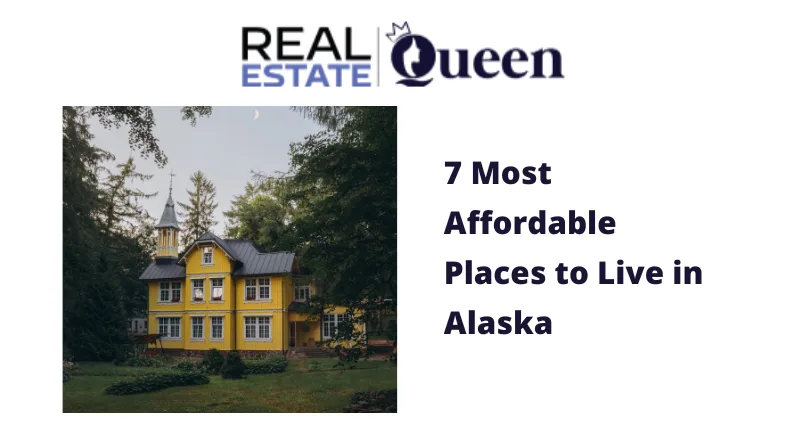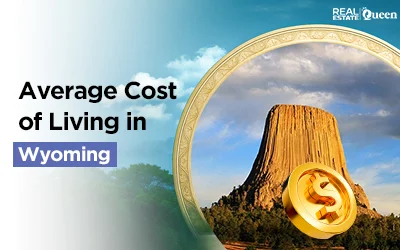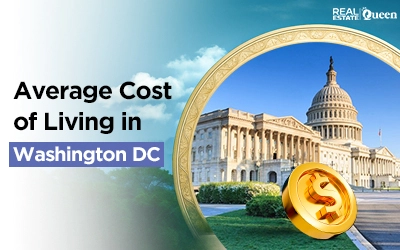
Alaska housing costs increased by 52% between 2018 and 2024 while the state maintains no personal income tax, saving residents thousands annually compared to high-tax states. The average cost of living in Alaska is 33% higher than the national average, yet in the most affordable places to live in Alaska, your housing dollar stretches significantly further.
Whether you dream of fishing for king salmon in the Kenai River or viewing the northern lights from your backyard in Fairbanks, Alaska’s most affordable cities make that authentic wilderness lifestyle accessible. This guide reveals where housing costs drop below state averages while maintaining access to Alaska’s unmatched outdoor recreation and tight-knit communities.
Key Takeaways
- Kenai offers the lowest housing costs with median home prices at $304,984 and rent averaging $1,114, representing 17% savings below Alaska’s average.
- Fairbanks provides exceptional rental value at $1,175 monthly average, ranking as Alaska’s most affordable rental market while offering university amenities.
- No state income tax saves Alaska residents approximately $3,750 annually on a $75,000 household income compared to states like New York or California.
- Palmer combines affordability with family appeal through highly-rated schools and Mat-Su Valley agricultural heritage, with homes averaging $384,706.
- Strategic location selection can reduce living costs by up to 35% below Alaska’s expensive markets like Unalaska while maintaining access to employment centers.
Comparing Most Affordable Places to Live in Alaska
| City | Median Home Price | Median Rent | Cost of Living vs US | Best For |
| Kenai | $304,984 | $1,114 | +17% | Fishing enthusiasts, retirees |
| Palmer | $384,706 | $1,101 | +18% | Families, agriculture lovers |
| Ketchikan | $380,964 | $1,214 | +22% | Tourism professionals, culture buffs |
| Wasilla | $363,621 | $1,105 | +23% | Young families, military |
| Homer | $369,327 | $1,180 | +26% | Artists, fishing enthusiasts |
| Fairbanks | $281,546 | $1,404 | +21% | Students, aurora enthusiasts |
| Anchorage | $373,986 | $1,405 | +23% | Career professionals, military |
7 Most Affordable Places to Live in Alaska in 2025
1. Kenai
Median Home Price: $304,984
Median Rent: $1,114
Cost of Living: 17% below Alaska average, 17% above US national average
Best For: Retirees seeking outdoor lifestyle, fishing enthusiasts, small-town families
Highlights: Kenai National Wildlife Refuge, world-class king salmon fishing, Holy Assumption Russian Orthodox Church
Commercial fishing boats dock alongside weekend anglers in this authentic Alaska town where home prices average 19% below the state median of $375,000. Kenai Central High School earns an 8/10 rating while the Kenai River provides year-round recreation from salmon runs to aurora viewing.
The Russian Orthodox heritage creates unique cultural depth with the oldest active Russian church in Alaska. Named “Most Affordable Alaska City 2024” by Saturday Night Science analysis, Kenai balances authentic fishing town character with practical amenities.
Limited job opportunities outside fishing and tourism present challenges, along with high heating costs during harsh winters. The 68% homeownership rate reflects strong community stability among the 7,477 residents.
👉Affordable living on the Kenai Peninsula. Start your Kenai homes for sale search today.
2. Palmer
Median Home Price: $384,706
Median Rent: $1,101
Cost of Living: 18% below Alaska average, 18% above US national average
Best For: Families with children, agriculture enthusiasts, Anchorage commuters
Highlights: Alaska State Fair grounds, Matanuska Valley farming, Chugach Mountains access
Historic farming community Palmer showcases world record vegetables in the Matanuska Valley, where 24-hour summer sunlight produces 90-pound cabbages. Palmer High School maintains a 7/10 rating while strong volunteer networks create exceptional family community support.
The Alaska State Fair brings annual celebration of agricultural heritage and pioneer spirit. Government workers and Anchorage commuters appreciate Palmer’s blend of rural character with suburban convenience, though limited entertainment options require travel to larger cities.
Current median home prices of $416,276 represent solid investment potential in Alaska’s Mat-Su Valley growth corridor. The median age of 38 reflects the strong family community among 6,091 residents.
👉Affordable living surrounded by Alaskan mountains. Start your Palmer homes for sale search today.
3. Ketchikan
Median Home Price: $380,964
Median Rent: $1,214
Cost of Living: 22% below Alaska average, 22% above US national average
Best For: Tourism industry professionals, outdoor enthusiasts, cultural history buffs
Highlights: World’s largest totem pole collection, Inside Passage gateway, Creek Street historic district
The “Salmon Capital of the World” stands on stilts over water where totem poles line busy streets and cruise ships bring global visitors to authentic Southeast Alaska. Ketchikan High School serves the diverse 8,168 residents while Totem Heritage Center preserves Native cultural exhibits.
Creek Street’s historic red-light district now houses galleries and shops creating unique tourist appeal. Featured in “Alaska’s Top Tourist Destinations with Livable Communities” 2024 report, Ketchikan balances scenic beauty with economic opportunity.
Heavy rainfall exceeding 150 inches annually and seasonal economy dependence challenge year-round residents, while the tourism industry provides diverse employment. The Inside Passage location offers spectacular natural access to Misty Fjords National Monument.
👉Affordable coastal living in Alaska’s First City. Start your Ketchikan homes for sale search today.
4. Wasilla
Median Home Price: $363,621
Median Rent: $1,105
Cost of Living: 23% below Alaska average, 23% above US national average
Best For: Young families, military personnel, dog mushing enthusiasts
Highlights: Official Iditarod restart location, Lake Wasilla recreation, Hatcher Pass access
Fast-growing Mat-Su Valley city Wasilla combines suburban convenience with wilderness access where dog mushing heritage runs deep through Iditarod connections. Iditarod Trail Headquarters provides year-round dog sledding experiences and cultural education.
Wasilla High School maintains 7/10 rating while the median age of 35 reflects young families choosing this growing community. The 9,267 population continues expanding as housing remains more affordable than Anchorage.
Listed among “Alaska’s Fastest Growing Affordable Communities” 2024, Wasilla attracts military personnel from nearby bases and Anchorage commuters. Rapid development strains infrastructure creating traffic congestion, while the loss of small-town character concerns long-term residents.
👉Affordable living in the Matanuska-Susitna Valley. Start your Wasilla homes for sale search today.
5. Homer
Median Home Price: $369,327
Median Rent: $1,180
Cost of Living: 26% below Alaska average, 26% above US national average
Best For: Artists, fishing enthusiasts, retirees seeking scenic beauty
Highlights: 4.5-mile Homer Spit, “Halibut Fishing Capital,” Kachemak Bay location
The “Halibut Fishing Capital of the World” creates unique bohemian-meets-maritime culture on spectacular Kachemak Bay where the famous Homer Spit extends 4.5 miles into the water. Homer High School earns 8/10 rating serving the highly educated community of 5,623 residents with median age 47.
Pratt Museum and numerous art galleries showcase the creative community nicknamed “Cosmic Hamlet by the Sea”. Named “Alaska’s Most Scenic Affordable Town” by Alaska Magazine 2024, Homer balances artistic culture with outdoor recreation access.
Summer tourist crowds create seasonal congestion while limited winter employment challenges year-round residents, though the stunning bay views and artist community maintain strong appeal. Higher food costs reflect the remote location and seasonal tourism economy.
👉Affordable living by Kachemak Bay. Start your Homer homes for sale search today.
6. Fairbanks
Median Home Price: $281,546
Median Rent: $1,404
Cost of Living: 29% below Alaska average, 21% above US national average
Best For: University students, aurora enthusiasts, military families
Highlights: University of Alaska Fairbanks, northern lights capital, Pioneer Park
Alaska’s “Golden Heart City” combines university energy with frontier spirit where the University of Alaska Fairbanks creates vibrant intellectual atmosphere. The average wage of $66,000 annually supports diverse population including students, military personnel, and government workers.
Lathrop High School serves the 32,496 residents with median age 33. The university presence provides cultural amenities unusual for Alaska’s interior.
Designated “Best Northern Lights Viewing City” by National Geographic 2024, Fairbanks offers world-class aurora viewing with 70+ subzero days annually. Extreme winter temperatures reaching -40°F create high heating costs and seasonal affective disorder concerns, while summer temperatures can reach 90°F.
👉Affordable living in Alaska’s Golden Heart City. Start your Fairbanks homes for sale search today.
7. Anchorage
Median Home Price: $373,986
Median Rent: $1,405
Cost of Living: 32% below Alaska average, 23% above US national average
Best For: Career professionals, military personnel, healthcare workers
Highlights: Alaska’s largest city, Tony Knowles Coastal Trail, Chugach State Park
Alaska’s largest city houses 290,674 residents representing 70% of the state’s population where urban amenities meet wilderness adventure. Strong Alaska Native cultural influence creates cosmopolitan atmosphere while Chugach State Park provides immediate outdoor access.
The University of Alaska Anchorage and diverse economy support median age 33 population. Listed in “America’s Best Places for Outdoor Recreation” 2024 by Outside Magazine, Anchorage offers career opportunities unavailable elsewhere in Alaska.
Urban traffic and higher crime rates compared to rural Alaska present challenges, while expensive dining and entertainment reflect big-city pricing. Ted Stevens International Airport and abundant pilots per capita demonstrate aviation-centered culture.
👉Affordable big-city living in Alaska’s largest city. Start your Anchorage homes for sale search today.
How We Ranked Alaska’s Most Affordable Cities in 2025
Our comprehensive analysis uses weighted criteria such as,
- Housing Costs (40%)
- Overall Cost of Living (25%)
- Economic Stability (25%)
- Economic Stability (15%)
- Quality of Life (10%)
- Location Accessibility (10%)
Primary data sources include Alaska Housing Finance Corporation Market Reports, RentCafe Alaska Cost Analysis 2024-2025, US Census American Community Survey 2022-2024, Houzeo Cost of Living Calculator, and Alaska Department of Labor workforce statistics. University of Alaska economic research centers and local municipality budget reports provided additional community-specific data verification.
What Drives Affordability in Alaska?
Alaska housing costs increased 52% between 2018 and 2024 while rental costs rose 24%, creating affordability challenges statewide. Remote locations reduce demand and prices in smaller communities, while larger cities like Anchorage command premium pricing due to employment concentrations and limited supply.
No state income tax saves residents approximately $3,750 annually on a $75,000 household income compared to high-tax states, while utilities average 24% higher than national costs due to climate and infrastructure challenges. Insurance and heating expenses significantly impact total living costs, with some interior communities experiencing extreme temperature variations requiring substantial energy consumption.
Smart Tips for Alaska Living
- Research heating costs thoroughly – Interior cities like Fairbanks require substantial heating budgets during 70+ subzero days annually
- Consider seasonal employment patterns – Tourism-dependent communities like Ketchikan and Homer experience significant winter job reductions
- Evaluate transportation access – Cities like Juneau and Kodiak rely on air or ferry service, increasing travel costs and limiting flexibility
- Factor in food costs – Remote locations pay premium prices for groceries, with some communities seeing 27% higher food costs than national average
- Investigate school quality – Palmer, Homer, and Sitka offer highly-rated schools (8/10) while maintaining affordable housing markets
- Plan for extreme weather – Arctic communities require specialized clothing, vehicle winterization, and emergency preparedness supplies
Should You Move to Alaska?
Most affordable places to live in Alaska prove that wilderness lifestyle remains accessible despite statewide housing increases averaging 52% since 2018. From Kenai’s authentic fishing culture at $304,984 median home prices to Fairbanks’ university town atmosphere with $281,546 housing costs, strategic location choices unlock significant savings while maintaining access to Alaska’s unmatched outdoor recreation.
The absence of state income tax, combined with tight-knit communities and spectacular natural settings, creates compelling value propositions for families, retirees, and adventure-seekers willing to embrace Alaska’s unique challenges and rewards. These 7 most affordable places to live in Alaska offer authentic Alaska living experiences at prices substantially below the state’s most expensive markets, making the Last Frontier dream achievable for budget-conscious residents.
👉Moving to Alaska in 2025? Discover budget-friendly Alaska homes for sale statewide and close digitally with Houzeo.
Frequently Asked Questions
What is the most affordable place to live in Alaska?
Alaska's most affordable city is Kenai with median home prices of $304,984 and average rent of $1,114, offering 17% savings below the state average.
What are the top 7 most affordable cities in Alaska?
The most affordable Alaska cities are Kenai ($304,984 median homes), Palmer ($384,706), Ketchikan ($380,964), Wasilla ($363,621), Homer ($369,327), Fairbanks ($281,546), Anchorage ($373,986).
Which Alaska cities are best for families on a budget?
For families on a budget, Palmer and Wasilla excel for budget-conscious families, offering highly-rated schools, growing communities, and median home prices below $385,000.
Are there affordable beach towns in Alaska?
Yes, Homer serves as Alaska's most affordable coastal community at $369,327 median home prices, featuring the famous 4.5-mile Homer Spit extending into Kachemak Bay. Kenai offers additional waterfront living at lower costs with Kenai River and Cook Inlet access, while Ketchikan provides Inside Passage coastal culture at $380,964 median housing costs.
What makes Alaska one of the most affordable states?
Alaska eliminates state income tax, saving residents $3,750+ annually on typical household incomes compared to high-tax states. Strategic city selection reveals markets like Kenai and Fairbanks offering housing costs 17-29% below state averages, while abundant natural resources and low population density create affordable living pockets throughout the state.






